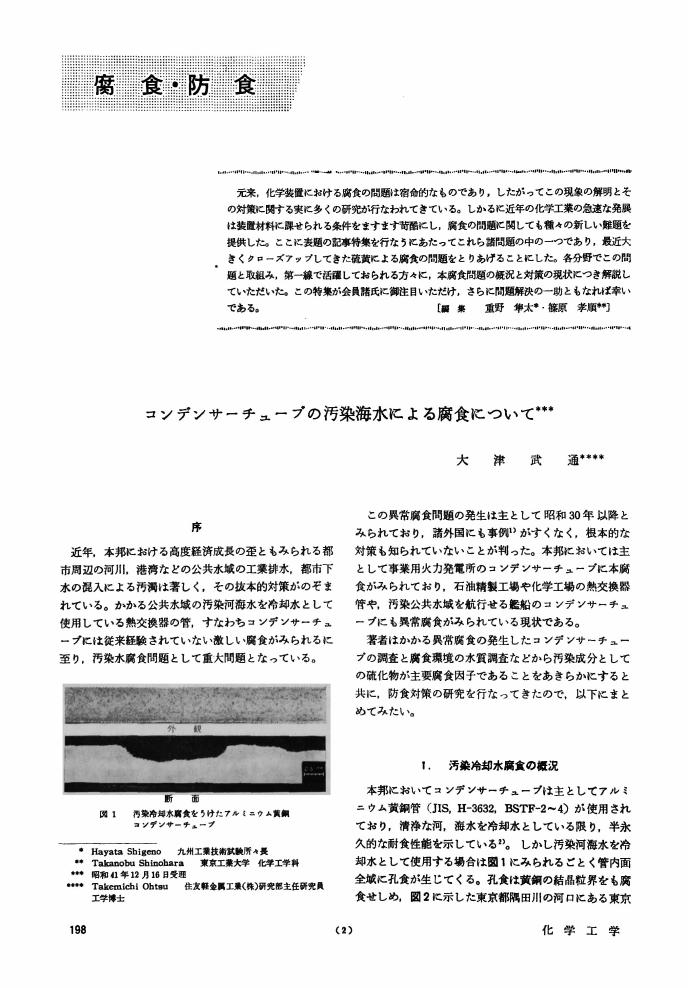2 0 0 0 軟鋼の流動腐食速度に及ぼす加工度の影響
- 著者
- 竹本 幹男 篠原 孝順 末沢 慶忠
- 出版者
- The Society of Chemical Engineers, Japan
- 雑誌
- 化学工学 (ISSN:03759253)
- 巻号頁・発行日
- vol.34, no.12, pp.1288-1295,a1, 1970
冷間引抜き軟鋼棒の稀塩酸流動液による腐食実験を行ない, 流動腐食速度に及ぼす加工度の影響についてつぎのことを明らかにした。<BR>i) 初腐食速度はいずれの流速においても加工度の増大にともない増加する。この主原因は, 冷間加工によるフェライト結晶粒の不均一化およびセメンタイトの変形にともなう水素ガス発生型カソード反応速度の増加である。<BR>ii) 腐食面の荒れ模様は, 加工度の増大にともない細かく複雑となる一方。最大アラサは小さくなる。<BR>iii) 冷間加工を受けた軟鋼の腐れしろまたは寿命の推定法を示した。
1 0 0 0 OA コンデンサーチューブの汚染海水による腐食について
- 著者
- 重野 隼太 篠原 孝順 大津 武通
- 出版者
- 公益社団法人 化学工学会
- 雑誌
- 化学工学 (ISSN:03759253)
- 巻号頁・発行日
- vol.31, no.3, pp.198-208, 1967-03-05 (Released:2010-10-07)
- 参考文献数
- 31
- 被引用文献数
- 1
1 0 0 0 OA 尿素合成塔における316L鋼の腐食に対するプロセス条件の影響と耐食性の推定法
- 著者
- 松本 桂一 篠原 孝順 笠松 昭宏
- 出版者
- Japan Society of Corrosion Engineering
- 雑誌
- 防食技術 (ISSN:00109355)
- 巻号頁・発行日
- vol.33, no.11, pp.643-648, 1984-11-15 (Released:2009-10-30)
- 参考文献数
- 13
- 被引用文献数
- 1 2
As corrosion failures of 316L in urea synthesis solutions are due to either the active region dissolution or the corroison at the transition zone from the passive to the transpassive region, effects of process variables of the urea reactor on these two types of corrosion were electrochemically examined in order to advance the reliability of corrosion preventive methods. For making simple methods to evaluate resistance of 316L to the corrosion at the transition zone from the passive to the transpassive region, seven 316L specimens were immersed in an urea synthesis solution and the results were discussed by comparison with the results of Huey test and chemical compositions of the test specimens. The conclusions obtained are as followws.(1) 316L for the urea reactor required more amount of air to be injected for preventing active dissolution as the temperature of the reactor rose or the molar ratio of H2O/CO2 increased.(2) Sulfide, an impurity in CO2 gas, had a very detrimental effect on passivation of 316L. As it is not practical to compensate the harmfulness of sulfide by increase of the amount of air injection, the content of sulfide in CO2 gas should be lowered before feeding to the urea plant.(3) For reducing the corrosion at the transition zone from the passive to the transpassive region, higher molar ratio of NH3/CO2, lower ratio of H2O/CO2 and lower temperature were advantageous.(4) Sulfide was also harmful to this corrosion.(5) Annealed 316L was subject to weight loss owing to general corrosion and intergranular corrosion simultaneously at the transition zone from the passive to the transpassive region. Resistance of 316L to these two types of corrosion were correlated with Cr content in 316L and results of Huey test, respectively.
